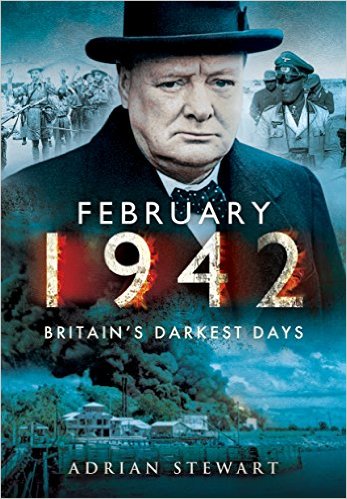
Finest Hour 173
Books, Arts, & Curiosities – Everything Old Is New Again

August 14, 2016
Finest Hour 173, Summer 2016
Page 42
Adrian Stewart, February 1942: Britain’s Darkest Days, Pen & Sword Military, 2015, 198 pages, £19.99. ISBN 978–1473821156
Review by Mark Klobas
Mark Klobas teaches history at Scottsdale Community College in Arizona and hosts a podcast for the New Books Network.

2025 International Churchill Conference
 In any argument for when was the lowest point of the Second World War for Great Britain, an excellent case can be made for February 1942. Though the entry of the United States into the conflict just two months before led Winston Churchill to exult that Britain’s victory was assured, the road to that triumph became costlier, and the result diminished because of Japan’s subsequent assault on Britain’s empire in Asia. Before that victory could be achieved, Britain would suffer a series of humiliating and tragic defeats, most dramatically and symbolically represented by the fall of the “eastern Gibraltar,” Singapore.
In any argument for when was the lowest point of the Second World War for Great Britain, an excellent case can be made for February 1942. Though the entry of the United States into the conflict just two months before led Winston Churchill to exult that Britain’s victory was assured, the road to that triumph became costlier, and the result diminished because of Japan’s subsequent assault on Britain’s empire in Asia. Before that victory could be achieved, Britain would suffer a series of humiliating and tragic defeats, most dramatically and symbolically represented by the fall of the “eastern Gibraltar,” Singapore.
Adrian Stewart outlines the events of that mensis horribilis in this short book. His focus is on operations in three theaters: North Africa, where the overextended Eighth Army was driven back by Erwin Rommel’s Afrika Korps; the English Channel, where the German battlecruisers Scharnhorst and Gneisenau and the heavy cruiser Prinz Eugen evaded the combined efforts of the Royal Navy and the Royal Air Force to destroy them; and Southeast Asia, where Japanese forces were in the midst of inflicting a series of defeats upon British, imperial, and allied forces on land, on sea, and in the air. Stewart traces much of the responsibility for this to Churchill’s decision the previous year to divert forces destined for Southeast Asia to Egypt. Buoyed, in Stewart’s view, by the recent success of Operation CRUSADER in rolling back Rommel’s forces to El Agheila in Libya, Churchill preferred to gamble on a victory in North Africa, instead of playing it safe by shoring up Britain’s military presence in the Far East.
A key element in the failure of this gamble was the poor guidance provided by the commander of British forces in the region, Claude Auchinleck. This highlights a recurring theme in Stewart’s book, as he emphasizes repeatedly the failure of leadership at the theater level. Just as Auchinleck receives the brunt of the criticism for the military debacle in North Africa, so too the explanation for the success of the “Channel dash” is credited in part to the lack of collaboration between the Admiralty and the RAF, while much of the blame for the deficiencies of the British military effort in Malaya and Burma is assigned to Archibald Wavell, who as Supreme Allied Commander in the theater was in charge of organizing a response to the Japanese offensives in the region. Yet this was just one component among many, for Stewart also notes that other factors, such as deficiencies in equipment, the logistical challenges posed by long distances, the disruption of supply lines by enemy forces, and a growing dispiritedness among soldiers as misfortune piled upon misfortune, combined to bring about this collective crisis.
Stewart’s description of these campaigns is both pointed and readable, yet his book suffers from a number of flaws. One is a lack of context, for while the author endeavors to provide background to the myriad events of that month, his effort is limited to military developments, with no consideration of the overall political or economic context in which the events took place. Consideration of the broader impact of the defeats Stewart describes is also absent, for there is no coverage of the public’s response in Britain to these events, nor is there any analysis of the role they played in the political discontent Churchill faced during that time. These are symptoms of what is the greatest problem with the book, which is the choice of sources Stewart uses in constructing his narrative. His bibliography is filled with several venerable titles about the war, with no reference to any primary source documents (even published sources such as the Companion Volumes to the Official Biography of Churchill are absent from it) or much of the modern secondary literature on the conflict. It is a classic case of a writer going into a room full of old books and walking out of it with a new one assembled from its contents. Because of this, while Stewart’s book can be recommended to readers new to the subject, those who have already read the classics upon which his efforts rest would be better advised to turn their attention elsewhere.
Subscribe
WANT MORE?
Get the Churchill Bulletin delivered to your inbox once a month.



